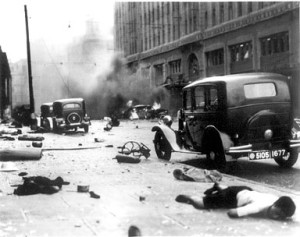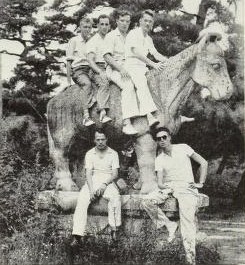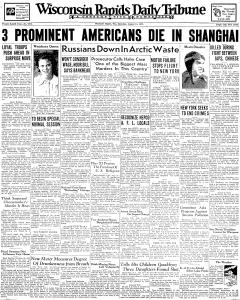The First American Casualty of World War II
- By Peter Harmsen
- 9 February, 2014
- No Comments
 On August 14, 1937, Chinese planes dropped several bombs over the international parts of Shanghai, in a tragic error that cost the lives of hundreds. Among the victims was Robert K. Reischauer, a promising 30-year-old political scientist from Princeton University. Later, family and friends would refer to him as the first American to be killed in World War II.
On August 14, 1937, Chinese planes dropped several bombs over the international parts of Shanghai, in a tragic error that cost the lives of hundreds. Among the victims was Robert K. Reischauer, a promising 30-year-old political scientist from Princeton University. Later, family and friends would refer to him as the first American to be killed in World War II.
“Bob was, in a sense, the first American casualty of World War II,” his younger brother, Edwin O. Reischauer, wrote in his memoirs My Life Between Japan and America. The Sinologist Luther Carrington Goodrich dedicated his book A Short History of the Chinese People, published the first time in 1943, to “To Robert K. Reischauer, first American casualty of the Second World War, who urged the writing of this.”
In fact, Reischauer was not the only American fatality on that day. Altogether four US citizens died within minutes of each other in Shanghai on August 14. Reischauer was a victim of bombs exploding at the Cathay and Palace Hotels at 4:27 pm near Shanghai’s waterfront in the International Settlement. The three others, Christian missionary Frank Rawlinson, businessman Hubert Honigsberg and his wife, were killed virtually on the spot when bombs exploded 18 minutes later a few hundred yards away in the French Concession.

The ill-fated American study group. Reischauer is top row, furthest to the right.
Reischauer was in Shanghai as part of an academic study group touring East Asia. Ironically, it had avoided the Beijing area further up north because of the fighting between Chinese and Japanese. By the time they reached Shanghai, combat in that city was considerably more intense. The group was staying at the Palace Hotel when the bombs struck, mortally injuring Reischauer. These are the basic facts that all the sources agree on. However, they differ on the details. Here is his brother’s account of what happened:
“One (bomb) landed in front of Bob’s hotel, blowing in the plate-glass windows, which sheared off one of his heels. An ex-Marine member of his party commandeered a motorcycle with a sidecar and, with Bob lying on a shutter on the sidecar, headed for the nearest hospital. Bob lightly remarked that a scholar could do very well without a leg, but by the time he arrived at the hospital he had lost so much blood that he went into shock and never recovered.”
Edwin O. Reischauer was writing decades after the events. Another more detailed account also exists, completed just days after the young scholar’s death. It is written by one of his co-travelers, William Verhage, a 37-year-old professor from Minnesota State Teachers College. In an article appearing in Sigma Phi Epsilon Journal in late 1937, Verhage describes how he found Reischauer in the devastated hotel lobby moments after the blast.

The American deaths in Shanghai were front-page news, although this paper got the number slightly wrong.
“He was standing with one arm on the counter and the other over the shoulder of a wounded Chinese. Bob couldn’t have stood up alone. One leg was absolutely no good. He didn’t talk, but it wasn’t necessary. We could see what was wrong. ‘Take me out of here,’ he asked. Nothing could be done in that mess.”
Verhage then goes on to describe how he and other tour group members moved Reischauer to a hotel room and carried out basic first aid, but soon concluded that he would have to be taken to hospital, or he might bleed to death.
“Potter (a member of the tour group) went downstairs to get help. An American marine was standing there beside a motorcycle with a sidecar. ‘Can you drive it?’ Potter asked him. ‘Yes,’ he said. ‘Will you take a man to the hospital?’ ‘Yes.’ ‘Wait here!’ We pulled the door off the clothes press and put it under the mattress. Six men carried him downstairs… I went with the sidecar, hanging on as best I could. We took him to the General Hospital… it was the nearest place.”
“They prepared to operate on him right away. He was ‘in shock’ as they call it. They couldn’t give him an anesthetic because of this. About all they could do was knot his arteries, clean up the wound and put him to bed. He started to relapse, and it wasn’t long before he died. He went easily, never suspecting I think that his life was at stake… At the hospital, he discussed only his wound. He was willing to lose his leg, he said. The doctor told him he would have to amputate it. All right, he said, I don’t mind — I don’t mind losing a leg.”
The question remains: Was Reischauer the first American casualty in World War II? We will probably never know for sure, but it’s highly likely that he was in fact number four. The three other Americans died in bomb blasts occurring after the one that hit Reischauer, but they died almost instantaneously, whereas the young Princeton scholar was still alive when he was brought to the hospital, probably by late afternoon.



 Copyright © 2025
Copyright © 2025
Leave a Reply